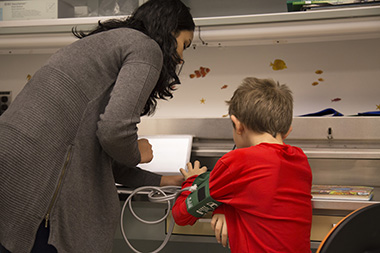Study Finds Children Log Excessive Screen-Time
Children born to first-time mothers or in home-based daycare spend the most time in front of screens
 |
|
A study done in collaboration with the School of Public Health as part of Upstate KIDS found that children are spending more time in front of screens. Photo by Patrick Dodson.
|
ALBANY, N.Y. (Dec. 19, 2019) – A study conducted by the University at Albany, the National Institutes of Health and New York University Langone Medical Center uncovered several new findings about the amount of time children spend watching television or using a computer or mobile device.
Published in JAMA Pediatrics, the study found that the average time children spend in front of screens increased from 53 minutes at 12 months per day to more than 150 minutes at 3 years – time periods that greatly exceed recommendations from the American Pediatric Academy that digital media exposure should be avoided for children under 18 months of age, introduced slowly to children 18 to 24 months of age and limited to an hour a day for children from 2 to 5 years of age.
Additional findings include:
- 87 percent of children had screen time exceeding recommendations from the American Pediatric Academy.
- Children were more likely to be in the highest percentile of screen time exposure if their parents had only a high school diploma or equivalent (more than twice as likely) or were children of first-time mothers (almost twice as likely).
- Compared to single-born children, twins were more likely to belong to the highest screen time group.
- Children in home-based care, whether provided by a parent, babysitter or relative, were more than twice as likely to have high screen time than those in center-based care.
- While screen time increased throughout toddlerhood, by age 7 and 8, screen time fell to under 1.5 hours per day. The researchers believe this is due to time consumed by school-related activities.
The team, including Erin Bell, professor of Environmental Health Sciences at UAlbany’s School of Public Health, analyzed data from the Upstate KIDS study. Upstate KIDS, an ongoing cohort-based study co-led by Bell, tracks the ongoing growth, motor and social development of more than 6,000 babies born to 5,000 mothers between 2008 and 2010 in 57 counties of upstate New York excluding New York City.
For this particular study, mothers of nearly 4,000 Upstate KIDS participants responded to questions on their children’s media habits when they were 12, 18, 24, 30 and 36 months of age, and then to similar questions when the children were 7 and 8 years old. The study compiled additional demographic information on the mothers and children from birth records and other surveys.
“This collaborative study led by our colleagues at Eunice Kennedy Shriver National Institute of Child Health and Human Development has made it clear that screen habits are developing earlier than recommended,” said Bell. “Given the concern that increased screen-time may impact child development, our results suggest an important need to develop strategies for reducing children’s screen time at very young ages to better meet the current AAP screen-time recommendations.”
![]() For more news, subscribe to UAlbany's RSS headline feeds
For more news, subscribe to UAlbany's RSS headline feeds
A comprehensive public research university, the University at Albany-SUNY offers more than 120 undergraduate majors and minors and 125 master's, doctoral and graduate certificate programs. UAlbany is a leader among all New York State colleges and universities in such diverse fields as atmospheric and environmental sciences, business, education, public health,health sciences, criminal justice, emergency preparedness, engineering and applied sciences, informatics, public administration, social welfare and sociology, taught by an extensive roster of faculty experts. It also offers expanded academic and research opportunities for students through an affiliation with Albany Law School. With a curriculum enhanced by 600 study-abroad opportunities, UAlbany launches great careers.


